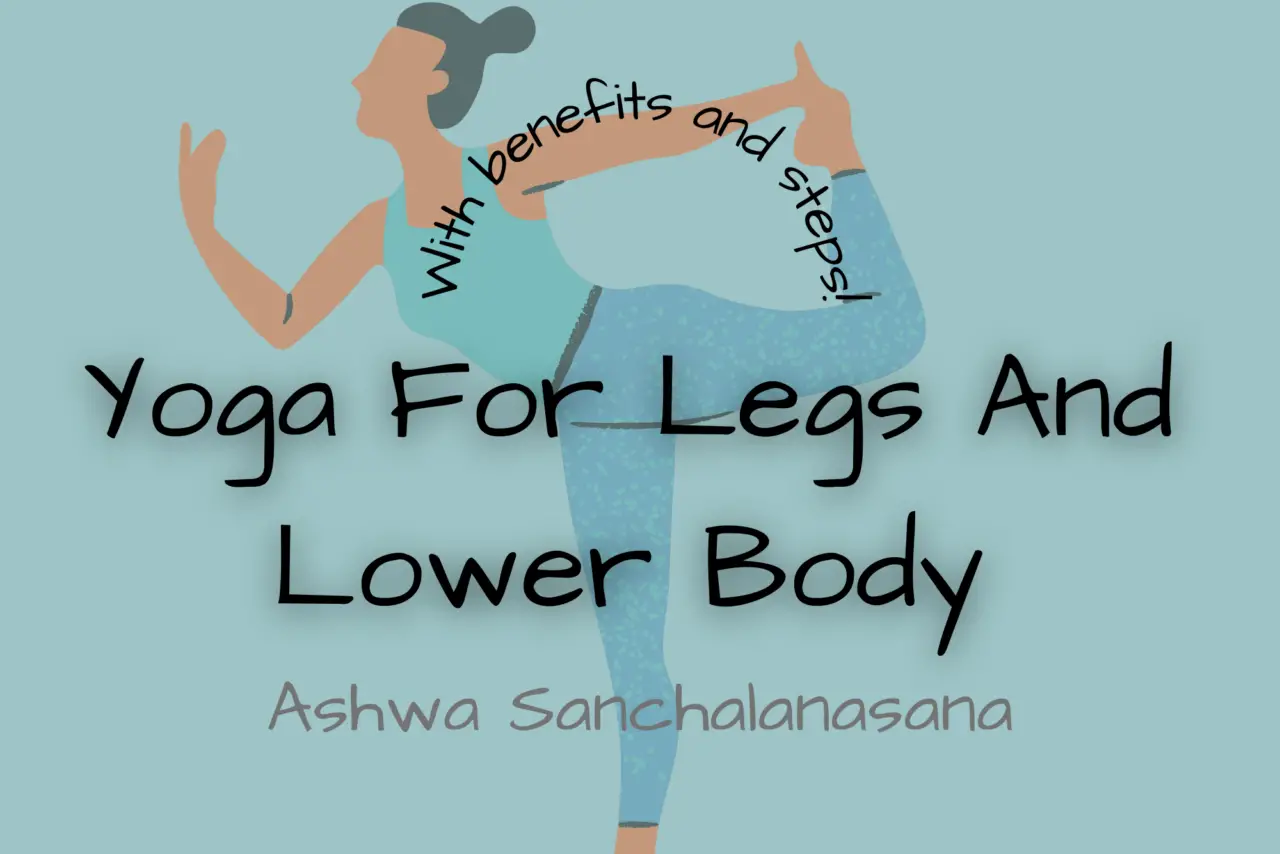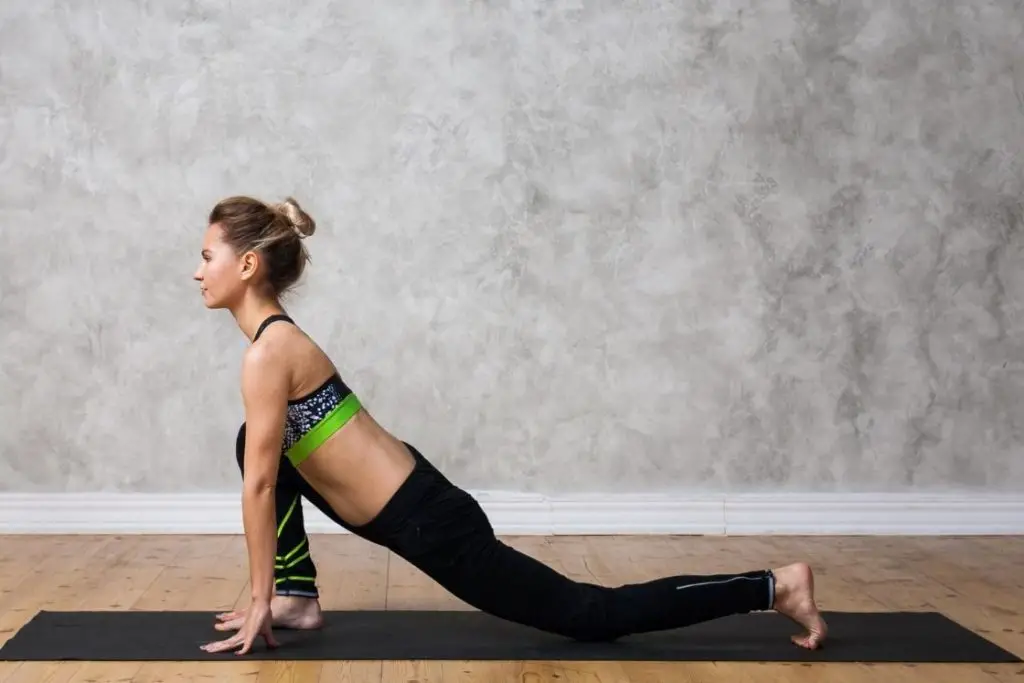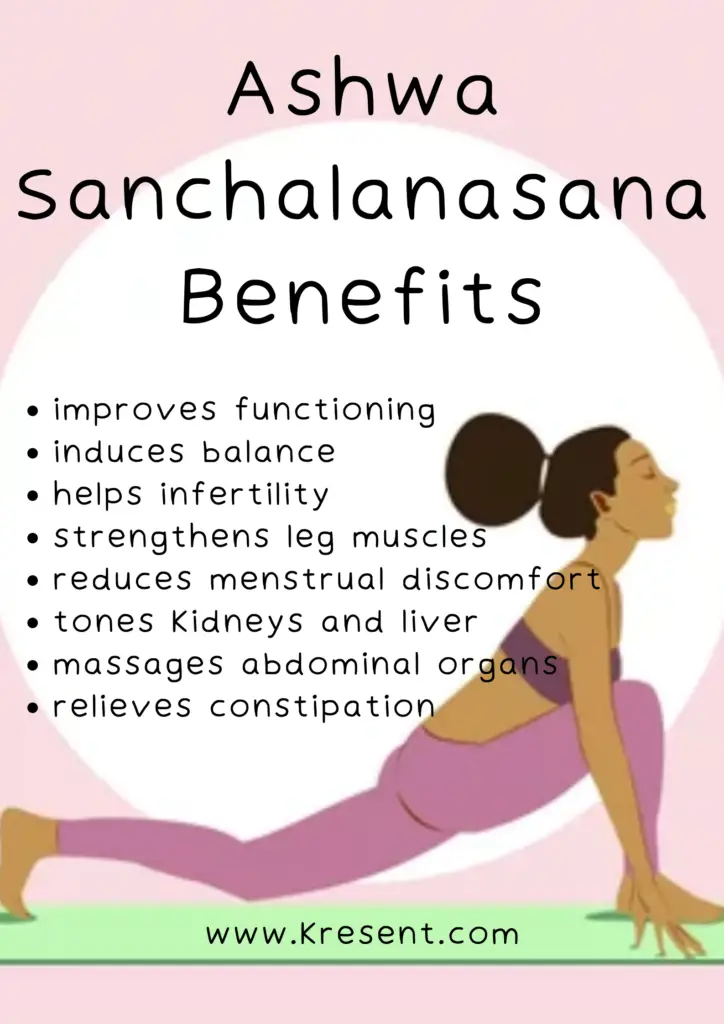AshwaSanchalanasana For Lower Body:
Jump To:
The Ashwa Sanchalanasana / Horse Posture is a wonderful support to people who play sports, cycle, walk and jog regularly. Ashwa Sanchalanasana is derived from three words. The Ashwa means Horse, Sanchalana meaning movement. Ashwa Sanchalanasana provides a range of physical benefits and is also considered a balancing posture because the spine lengthens. Check out more yoga asanas with detailed steps.

I feel that the practice of yoga works not only to heal and strengthen the body but also to open the mind to imbibing qualities that we admire in Nature. Like the tree’s steadfast strength, the nimble agility of the birds, the awe-inspiring energy of the lion, and so on.
The horse is, of course, known for the fluid strength of its legs and its ability to turn, jump, duck and dodge at a moment’s notice. Incorporate the Ashwa Sanchalanasana posture into your pre and post-workout / game routine. The posture trains the muscle structures of your lower body to become stronger and agile.
Ashwa Sanchalanasana (Equestrian/Horse Posture):
Ashwa Sanchalanasana or the equestrian pose is an amazing pose to stretch and tone the hips, legs, quadriceps, and groin. The asana also opens the chest and stretches the muscles of the back.
It is an excellent pose to beat indigestion, and constipation. Here is some more yoga for digestion. Even sciatica (lower back) pain (yoga for sciatica) can become better with this horse posture.
Ashwa Sanchalanasana or the Equestrian pose is part of the Sun Salutation series of asanas. It appears as the 4th pose and the 9th pose in Surya Namaskara. Check out how to do Surya namaskar.

Ashwa Sanchalanasana Steps:
- Stand at the front of a yoga mat with your feet hip-width apart.
- Bend forward from your hips and place your hands on either side of your feet.
- Your knees can bend slightly. Bend the left knee and take your right leg back as much as possible. Balance the right leg on the front of your foot (the ball of the foot), keep your knee straight, and push your heel backward to a limit that you can manage.
- Gently push your groin towards the floor without bending the right knee. Breathe normally throughout. Now, bring your focus to your torso, open your chest, lengthen your spine and lift your chin up towards the ceiling.
- Hold this posture for eight deep breaths, release the posture and repeat the same for the other leg. Take a break between each side if needed.
Ashwa Sanchalanasana Benefits:

- The pose massages the abdominal organs and improves their functioning, strengthens the leg muscles, and induces balance in the nervous system.
- Lengthens the spine and strengthens the muscles of the chest, opening the heart and increasing lung capacity.
- Tones the kidney and liver.
- Increases willpower, courage, and determination.
- Relieves constipation
- Helps Infertility
- Alleviates menstrual discomfort.
Precautions:
People with knee injuries and neck problems should take extra care or completely avoid doing this asana based on the severity.
Also, pregnant women should be careful while they stretch out the leg back.
What is the benefit of ashwa Sanchalanasana?
Benefits of Ashwa Sanchalanasana (Equestrian Pose):
- Stretches spine therefore increasing the flexibility of the back.
- Strengthens the knee and ankles, opens up groin and hips.
- Strengthens the muscles of the chest hence enhances lung capacity.
- Tones and massages kidney, liver leading to their well functioning.
What is the meaning of ashwa Sanchalanasana?
In yoga practice, the equestrian pose, or ashwa sanchalanasana, is a balancing posture that teaches the practitioner how to align opposing forces to create stability. The name comes from Sanskrit, and translates literally as horse (ashva) stepping movement (sanchalana) seat (asana).
How do you pronounce ashwa Sanchalanasana?
Low Lunge: Ashwa Sanchalanasana LOW LUNGE. For video instructions of this pose, please see here. Pronunciation in Sanskrit. AH-Swah San-CHA-La-Nasana. Benefits. Opens your groins and hips.
How do you do equestrian pose?
What are the benefits of Dandasana?
The Benefits of Staff Pose: Helps improve posture. Strengthens back muscles. Lengthens and stretches the spine. May help to relieve complications related to the reproductive organs. Stretches shoulders and chest. Nourishes your body’s resistance to back and hip injuries. Helps to calm brain cells.
What are the benefits of Pranamasana?
Pranamasana is a simple standing yoga posture that generally is the first and last Asana of any yoga session. It is a very easy and effortless posture that comes with great health benefits including nervous system strengthening, digestion improvement, body posture maintenance, and mental calmness.
Who should not do Shashankasana?
Precautions for Shashankasana (Rabbit Pose) In the final position, the buttocks must be touching the heels. People suffering from any of these conditions should avoid practicing Shashankasana: vertigo, high blood pressure, knee problems, or slipped disc. Pregnant women should also avoid practicing this asana.
What is Dandasana?
Dandasana (Sanskrit: दण्डासन; IAST: Daṇḍāsana) or Staff Pose is a seated asana in modern yoga as exercise.
What is Hastapadasana?
Hastapadasana (“Hand-to-Foot Pose”) is any of several asanas in modern yoga where the hands grasp one or both feet: Utthita Pādāṅguṣṭhāsana, a standing pose in which one leg is raised to the face and grasped. Uttanasana, the standing forward bend. Upavishta Konasana, the wide-angle seated forward bend.
What are the benefits of Anjaneyasana?
Releases tension in your hips. Stretches your hamstrings, quads, and groin. Strengthens your knees. Helps build mental focus.
What are the benefits of chaturanga?
Strengthens your back and core Similar to plank exercises, this asana aligns your whole body and builds strength in your erector spinae, the muscles on either side of your spine. This helps improve core strength, posture, and stability. Mastering Chaturanga can help you build functional strength.
What are the benefits of Padahastasana?
Benefits of Padahastasana: Massages the digestive organs. Alleviates flatulence, constipation, and indigestion. Spinal nerves are stimulated and toned. Increases vitality. Improves metabolism. Improves concentration. Helps with nasal and throat diseases.